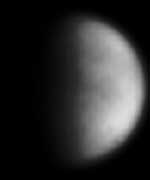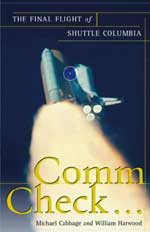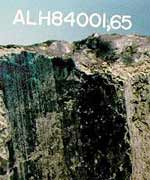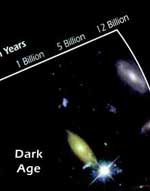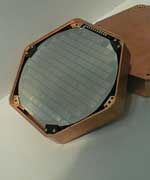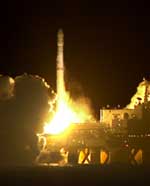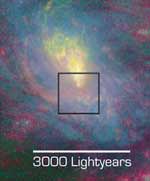
Image credit: ESO
Fulfilling an old dream of astronomers, observations with the Very Large Telescope Interferometer (VLTI) at the ESO Paranal Observatory (Chile) have now made it possible to obtain a clear picture of the immediate surroundings of the black hole at the centre of an active galaxy. The new results concern the spiral galaxy NGC 1068, located at a distance of about 50 million light-years.
They show a configuration of comparatively warm dust (about 50?C) measuring 11 light-years across and 7 light-years thick, with an inner, hotter zone (500?C), about 2 light-years wide.
These imaging and spectral observations confirm the current theory that black holes at the centres of active galaxies are enshrouded in a thick doughnut-shaped structure of gas and dust called a “torus”.
For this trailblazing study, the first of its kind of an extragalactic object by means of long-baseline infrared interferometry, an international team of astronomers [2] used the new MIDI instrument in the VLTI Laboratory. It was designed and constructed in a collaboration between German, Dutch and French research institutes [3].
Combining the light from two 8.2-m VLT Unit Telescopes during two observing runs in June and November 2003, respectively, a maximum resolution of 0.013 arcsec was achieved, corresponding to about 3 light-years at the distance of NGC 1068. Infrared spectra of the central region of this galaxy were obtained that indicate that the heated dust is probably of alumino-silicate composition.
The new results are published in a research paper appearing in the May 6, 2004, issue of the international research journal Nature.
NGC 1068 – a typical active galaxy
Active galaxies are among the most spectacular objects in the sky. Their compact nuclei (AGN = Active Galaxy Nuclei) are so luminous that they can outshine the entire galaxy; “quasars” constitute extreme cases of this phenomenon. These cosmic objects show many interesting observational characteristics over the whole electromagnetic spectrum, ranging from radio to X-ray emission.
There is now much evidence that the ultimate power station of these activities originate in supermassive black holes with masses up to thousands of millions times the mass of our Sun, cf. e.g., ESO PR 04/01. The one in the Milky Way galaxy has only about 3 million solar masses, cf. ESO PR 17/02. The black hole is believed to be fed from a tightly wound accretion disc of gas and dust encircling it. Material that falls towards such black holes will be compressed and heated up to tremendous temperatures. This hot gas radiates an enormous amount of light, causing the active galaxy nucleus to shine so brightly.
NGC 1068 (also known as Messier 77) is among the brightest and most nearby active galaxies. Located in the constellation Cetus (The Whale) at a distance of about 50 million light-years, it looks like a rather normal, barred spiral galaxy. The core of this galaxy, however, is very luminous, not only in optical, but also in ultraviolet and X-ray light. A black hole with a mass equivalent to about 100 million times the mass of our Sun is required to account for the nuclear activity in NGC 1068.
The VLTI observations
On the nights of June 14 to 16, 2003, a team of European astronomers [2] conducted a first series of observations to verify the scientific potential of the newly installed MIDI instrument on the VLTI. They also studied the active galaxy NGC 1068. Already at this first attempt, it was possible to see details near the centre of this object, cf. ESO PR 17/03.
MIDI is sensitive to light of a wavelength near 10 ?m, i.e. in the mid-infrared spectral region (“thermal infrared”). With distances between the contributing telescopes (“baselines”) of up to 200 m, MIDI can reach a maximum angular resolution (image sharpness) of about 0.01 arcsec. Equally important, by combining the light beams from two 8.2-m VLT Unit Telescopes, MIDI now allows, for the first time, to perform infrared interferometry of comparatively faint objects outside our own galaxy, the Milky Way.
With its high sensitivity to thermal radiation, MIDI is ideally suited to study material in the highly obscured regions near a central black hole and heated by its ultraviolet and optical radiation. The energy absorbed by the dust grains is then re-radiated at longer wavelengths in the thermal infrared spectral region between 5 and 100 ?m.
The central region in NGC 1068
Additional interferometric observations were secured in November 2003 at a baseline of 42 m. Following a careful analysis of all data, the achieved spatial resolution (image sharpness) and the detailed spectra have allowed the astronomers to study the structure of the central region of NGC 1068.
They detect the presence of an innermost, comparatively “hot” cloud of dust, heated to about 500?C and with a diameter equal to or smaller than the achieved image sharpness, i.e. about 3 light-years. It is surrounded by a cooler, dusty region, with a temperature of about 50?C, measuring 11 light-years across and about 7 light-years thick. This is most likely the predicted central, disc-shaped cloud that rotates around the black hole.
The comparative thickness of the observed structure (the thickness is ~ 65% of the diameter) is of particular relevance in that it can only remain stable if subjected to a continuous injection of motion (“kinetic”) energy. However, none of the current models of central regions in active galaxies provide a convincing explanation of this.
The MIDI spectra, covering the wavelength interval from 8 – 13.5 ?m, also provide information about the possible composition of the dust grains. The most likely constituent is calcium aluminum-silicate (Ca2Al2SiO7), a high-temperature species that is also found in the outer atmospheres of some super-giant stars. Still, these pilot observations cannot conclusively rule out other types of non-olivine dust.
Original Source: ESO News Release

